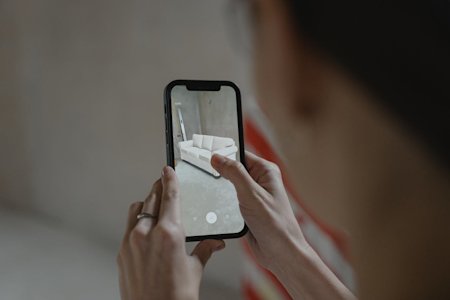Augmented reality is no longer a futuristic concept confined to science fiction. Today, AR is a powerful technology with the potential to revolutionize numerous industries by merging the digital and physical worlds.
This seamless integration of the virtual with the real world is what makes AR so compelling. Whether it's through a smartphone, tablet, or specialized AR glasses, this technology is providing new ways to visualize data, interact with digital content, and perform tasks more efficiently. The implications are vast, from enabling remote workers to receive real-time assistance to transforming how consumers shop, learn, and play.
As AR continues to evolve, it’s important to understand not just what it is, but how it works, the types of AR available, and its potential risks and benefits. This blog will guide you through the fundamentals of AR, explore its practical applications.
What is Augmented Reality (AR)?
Augmented reality (AR) is a technology that enhances the physical world by superimposing digital elements onto real-world environments, providing an enriched, interactive experience. Unlike virtual reality (VR), which immerses users in a completely virtual environment, AR maintains a connection to the real world, adding layers of digital information to what users see, hear, and feel in their physical surroundings.
The key feature of AR is its ability to enhance real-world experiences by providing additional information and context. This can be as simple as showing navigation instructions on a car’s windshield or as complex as enabling engineers to visualize 3D models of machinery in their actual environment. As AR technology advances, its applications are expanding rapidly, making it a crucial tool in various industries.
At its core, AR transforms the way we interact with the world by bridging the gap between the digital and physical realms. This technology is not just an overlay of information but a means to create more meaningful, efficient, and immersive experiences in everyday life and professional settings.
Understanding Augmented Reality: Examples, Types, and Key Comparisons
To fully appreciate the transformative potential of AR, it's essential to delve deeper into its various aspects, including real-world examples, different types of AR, and how it compares to related technologies. This section will explore these elements, providing a clear understanding of how AR fits into the broader landscape of immersive technologies.
Popular Examples of Augmented Reality
Augmented reality has made significant strides in both consumer and professional domains. Here are some notable examples of how AR is being used today:
Pokémon GO: Perhaps the most famous example of AR in the consumer market, Pokémon GO is a mobile game that overlays virtual creatures onto the real world through a smartphone’s camera. Players can see and interact with these creatures as if they were in the physical environment.
IKEA Place: This app allows users to visualize how furniture would look in their homes before making a purchase. By using AR, the app overlays 3D models of furniture onto a real-time view of the user's room, helping them make informed buying decisions.
Google Lens: This tool leverages AR to provide information about objects that users point their smartphone cameras at. For example, pointing Google Lens at a plant might identify the species, while pointing it at a restaurant could bring up reviews and menu options.
Microsoft HoloLens: Used in professional settings, the HoloLens is an AR headset that allows users to see and interact with holographic images overlaid on the real world. It’s used in fields like engineering, healthcare, and education to provide immersive training, design visualization, and collaborative workspaces.
Snapchat Filters: A more casual example, Snapchat’s AR filters allow users to apply fun effects to their selfies by mapping facial features and overlaying digital enhancements in real-time. This technology has since expanded into advertising, where brands create custom AR experiences for marketing campaigns.
These examples demonstrate the versatility of AR, ranging from entertainment and retail to professional applications, highlighting its growing importance across various sectors.
Augmented Reality (AR) vs. Virtual Reality (VR) vs. Mixed Reality (MR)
While AR, VR, and MR are often discussed together, they are distinct technologies that offer different experiences:
Augmented Reality: As previously mentioned, AR overlays digital content onto the real world. The user remains connected to their physical environment, with the digital elements enhancing their experience. AR is widely accessible through smartphones, tablets, and AR glasses, making it a more prevalent technology in everyday use.
Virtual Reality: In contrast to AR, VR immerses users in a completely virtual environment, cutting off their interaction with the real world. This is achieved through VR headsets that block out the physical surroundings and replace them with a simulated 3D environment. VR is commonly used in gaming, simulations, and training programs where immersion is crucial.
Mixed Reality: MR combines elements of both AR and VR, allowing digital and physical objects to coexist and interact in real-time. MR devices, like Microsoft’s HoloLens, enable users to manipulate digital content as if it were part of the real world, creating a more integrated experience. MR is often used in complex professional environments where seamless interaction between the digital and physical is required.
Types of Augmented Reality
There are several types of AR, each with unique characteristics and applications:
Marker-Based AR: This type of AR relies on visual markers, such as QR codes or images, to trigger the display of digital content. When the AR device recognizes the marker, it overlays the corresponding digital information onto the real world. Marker-based AR is commonly used in marketing, gaming, and education to provide interactive experiences.
Markerless AR: Also known as location-based AR, this type doesn’t require specific markers to function. Instead, it uses GPS, accelerometers, and digital compasses to determine the user’s location and orientation, overlaying relevant digital content onto the environment. An example of markerless AR is Google Maps’ Live View, which overlays navigation instructions onto the real world as seen through a smartphone camera.
Projection-Based AR: In this type of AR, digital content is projected onto physical surfaces, allowing users to interact with the content as if it were part of the environment. This method is often used in exhibitions, art installations, and industrial settings where large-scale visualizations are needed.
Superimposition-Based AR: Superimposition AR replaces or enhances parts of the real-world view with digital elements. For instance, in healthcare, superimposition AR can overlay digital images of organs onto a patient’s body to assist surgeons during operations.
Outlining AR: Outlining AR uses image recognition to detect the edges and outlines of objects in the real world, overlaying digital outlines onto these objects to enhance visualization. This type is often used in architectural design and automotive industries to highlight the structure and shape of objects.
The Pros and Cons of AR
Like any technology, AR comes with its own set of advantages and disadvantages:
Pros:
Enhanced Experience: AR enriches the user experience by providing additional information and interactive elements, making tasks more engaging and efficient.
Improved Learning and Training: AR can make education and professional training more effective by providing immersive, hands-on experiences that are both engaging and informative.
Increased Accessibility: With the proliferation of smartphones and tablets, AR is more accessible than ever, allowing a wide range of users to experience and benefit from the technology.
Cons:
Privacy Concerns: AR’s ability to overlay digital content on the real world raises potential privacy issues, particularly when AR applications collect data from the user’s environment.
Technical Limitations: The quality of AR experiences can vary depending on the device and environment, with factors like lighting and object recognition accuracy playing a significant role.
High Development Costs: Developing sophisticated AR applications can be expensive, requiring specialized skills and resources that may not be available to all organizations.
Despite these challenges, the benefits of AR often outweigh the drawbacks, especially as technology continues to improve. As AR becomes more integrated into everyday life, its potential to transform industries and enhance user experiences is only expected to grow.
How Augmented Reality Technology Works
AR technology is a complex blend of hardware and software designed to overlay digital content onto the real world, creating an enriched interactive experience. To understand how AR works, it's essential to break down the key components and processes involved in this technology.
1. Hardware Components
The hardware used in AR systems is crucial for capturing the real-world environment, processing the data, and displaying the augmented content. The primary hardware components include:
Cameras and Sensors: AR devices, such as smartphones, tablets, or AR glasses, rely on cameras and various sensors to capture the real-world environment. These sensors, including accelerometers, gyroscopes, and GPS, help the device understand its position, orientation, and movement in space. The data from these sensors is crucial for accurately overlaying digital content onto the physical world.
Processors: The processing power of an AR device is another critical factor. High-performance processors are needed to analyze the real-world data captured by the cameras and sensors in real time. This includes tasks like recognizing objects, tracking movement, and rendering 3D models. The processor must handle these tasks quickly to ensure that the augmented content aligns seamlessly with the real world.
Displays: The display is where the user sees the augmented content overlaid onto their view of the real world. This can be a screen on a smartphone or tablet, or transparent lenses in AR glasses. The quality and clarity of the display are vital for creating a convincing and immersive AR experience.
Input Devices: In more advanced AR systems, input devices such as controllers, gloves, or voice recognition systems allow users to interact with the digital content. These inputs can trigger changes in the AR environment, making the experience more dynamic and interactive.
2. Software and Algorithms
The software behind AR is responsible for interpreting the data captured by the hardware and generating the digital content that is overlaid onto the real world. Key software components include:
Computer Vision: Computer vision algorithms are at the heart of AR technology. These algorithms analyze the data from cameras and sensors to identify objects, surfaces, and environments in the real world. By recognizing and understanding the context of the real-world scene, the AR system can determine where and how to overlay digital content accurately.
Simultaneous Localization and Mapping (SLAM): SLAM is a method used by AR systems to build a map of an unknown environment while simultaneously tracking the device’s location within that environment. This process is crucial for maintaining the accuracy of the digital overlays as the user moves through the real world. SLAM ensures that the augmented content remains in the correct position relative to the physical surroundings.
Rendering Engine: The rendering engine is responsible for generating the visual content seen in AR. It takes the 3D models, animations, and other digital elements and overlays them onto the real-world scene captured by the camera. The rendering engine must do this in real time, ensuring that the augmented content is responsive and moves naturally with the user’s perspective.
Tracking and Registration: Tracking refers to the system’s ability to follow the user’s movements and adjust the digital content accordingly. Registration is the process of aligning the digital content with the physical world so that it appears in the correct location and orientation. Accurate tracking and registration are essential for a convincing AR experience, as any misalignment can break the illusion and reduce the effectiveness of the technology.
3. Workflow of Augmented Reality
The process of creating an AR experience involves several steps, starting with the capture of the real-world environment and ending with the display of augmented content. Here’s a simplified workflow:
Environment Capture: The AR device uses its camera and sensors to capture the real-world environment. This includes taking images or video of the surroundings and collecting data on the device’s position and orientation.
Data Processing: The captured data is processed by the device’s processor. Computer vision algorithms analyze the images to identify key features in the environment, such as surfaces, objects, and boundaries. This information is used to create a digital map of the real-world environment.
Digital Content Generation: Based on the processed data, the AR system generates the appropriate digital content to overlay onto the real world. This could be anything from simple text and images to complex 3D models and animations.
Tracking and Alignment: As the user moves, the AR system continuously tracks their position and adjusts the digital content to ensure it stays aligned with the real-world environment. This involves updating the digital content in real-time to reflect changes in the user’s perspective.
Display: Finally, the augmented content is displayed on the device’s screen or through AR glasses, seamlessly integrated with the user’s view of the real world. The user can then interact with the digital content as if it were part of their physical environment.
4. Challenges in AR Technology
While AR technology has made significant advancements, it still faces several challenges that developers and engineers are working to overcome:
Latency: For AR to be effective, the digital content must be rendered and displayed with minimal delay. High latency can cause a lag between the user’s movements and the corresponding updates in the AR environment, breaking the illusion of seamless integration.
Environmental Variability: AR systems must be able to function in a wide range of environments, from well-lit indoor spaces to outdoor settings with varying lighting conditions. Ensuring that the AR experience remains accurate and consistent across different environments is a significant challenge.
Power Consumption: The continuous processing and rendering required for AR can be power-intensive, particularly on mobile devices. Balancing the performance of AR applications with the device’s battery life is a critical consideration.
Privacy and Security: As AR systems often require access to cameras, location data, and other sensitive information, ensuring user privacy and protecting against potential security threats are important concerns.
Despite these challenges, ongoing research and development in AR technology are leading to more robust and versatile solutions, making AR an increasingly integral part of our digital experiences.
Augmented Reality: Security Risks
As AR continues to grow in popularity and find applications across various industries, it also presents new security challenges that need to be addressed. While AR offers numerous benefits, it can also expose users and organizations to several risks if not implemented with proper safeguards. This section will explore some of the most significant security risks associated with AR technology.
Data Privacy Concerns: One of the primary security risks of AR technology is the potential for breaches of data privacy. AR applications often require access to a user’s camera, microphone, location, and sometimes even personal information. This data can be sensitive, especially when AR applications are used in personal or professional environments.
Phishing and Social Engineering Attacks: AR technology can be manipulated to create highly convincing phishing or social engineering attacks. By overlaying digital content onto the real world, attackers can deceive users into interacting with malicious elements disguised as legitimate features.
Unauthorized Access to AR Devices: AR devices, especially those used in professional or sensitive environments, can become targets for unauthorized access. If an AR device is compromised, the attacker could gain control over the device’s camera, microphone, and other sensors, allowing them to spy on users or gather sensitive data.
Content Manipulation and Misinformation: AR technology blurs the lines between reality and the digital world, making it easier for malicious actors to spread misinformation or manipulate content in ways that are difficult to detect.
Physical Safety Risks: While not a direct cybersecurity issue, the integration of digital content with the real world can also pose physical safety risks if not managed properly.AR can be highly immersive, leading to distractions that might result in accidents, especially when users are in public or hazardous environments. For instance, using AR while driving or walking in a busy area could lead to collisions or other safety incidents.
Intellectual Property Theft: In professional and creative industries, AR can be used to visualize proprietary designs, prototypes, or other sensitive intellectual property. Without proper security measures, this digital content can be captured, copied, or stolen by unauthorized parties.
Mitigating AR Security Risks
To mitigate these security risks, it is crucial for developers, businesses, and users to implement strong security practices when using AR technology:
Data Encryption: Ensure that all data collected and transmitted by AR applications is encrypted to protect against unauthorized access.
Regular Software Updates: Keep AR applications and devices updated with the latest security patches to protect against known vulnerabilities.
User Education: Educate users about the potential risks of AR and how to recognize phishing or social engineering attempts within AR environments.
Access Controls: Implement strict access controls on AR devices, especially in professional settings, to prevent unauthorized access.
Ethical Use of AR: Promote the ethical use of AR technology, ensuring that it is not used to mislead, manipulate, or harm users.
As AR technology continues to evolve, addressing these security risks will be essential to ensure that it can be safely integrated into both personal and professional settings. With the right precautions, the benefits of AR can be fully realized without compromising security.
Industries Leveraging AR for Enhanced Business Processes
AR is revolutionizing various industries by enhancing processes, improving customer experiences, and boosting operational efficiency. Here’s how different sectors are utilizing AR:
Manufacturing and Engineering: AR improves precision in design and production by overlaying 3D models onto physical spaces. It guides assembly lines with step-by-step instructions and enhances training by simulating real-world scenarios.
Healthcare and Medicine: AR aids surgeons with real-time anatomical overlays, allowing for more precise and minimally invasive procedures. It also enhances medical training and patient education through interactive, 3D visualizations.
Retail and E-Commerce: AR bridges online and in-store shopping by allowing customers to virtually try on products, visualize furniture in their homes, and navigate stores with interactive guides and product information.
Education and Training: AR transforms learning by bringing educational content to life, overlaying digital information onto textbooks, and providing immersive training simulations that mimic real-world environments.
Real Estate and Construction: AR offers virtual property tours, even for unbuilt properties, and overlays digital blueprints onto job sites. It also allows real estate agents to showcase design options, helping clients make informed decisions.
Entertainment and Media: AR adds a new dimension to gaming, letting players interact with digital characters in the real world. It enhances live events with digital effects and makes media content interactive with animations and 3D models.
Tourism and Travel: AR enriches the visitor experience by providing virtual tours and overlaying historical facts and 3D reconstructions onto physical environments, offering a deeper understanding of destinations.
Augmented Reality for Enhancing Remote Support Capabilities
AR is revolutionizing remote support by enabling technicians to diagnose and resolve issues without the need to be physically on-site. This transformative technology is particularly valuable in industries where downtime can be costly, allowing for faster problem resolution and enhanced collaboration between remote experts and on-site personnel.
Benefits of Augmented Reality in Remote Support
Increased Efficiency: AR allows technicians to view the real-time environment of a remote location through a connected camera, enabling them to identify issues quickly and provide precise guidance to on-site staff. By overlaying digital annotations onto the physical environment, technicians can direct on-site personnel to perform specific actions, reducing the time it takes to resolve problems.
Reduced Costs: One of the most significant advantages of using AR in remote support is the reduction in costs associated with travel and on-site visits. AR technology allows technicians to support multiple locations simultaneously, minimizing the need for costly truck rolls and reducing overall support expenses.
Enhanced Collaboration: AR fosters better collaboration between remote experts and on-site workers by enabling real-time visual communication. Through features such as camera sharing and interactive annotations, experts can guide non-technical staff or train apprentices, ensuring that issues are resolved accurately and efficiently.
Improved Customer Satisfaction: With AR, customers can receive immediate and effective support, leading to faster issue resolution and less downtime. The ability to visually demonstrate and guide solutions enhances the customer experience, leading to higher satisfaction levels.
Introducing Splashtop AR for Remote Support
Splashtop's AR remote assistance software empowers remote support teams with advanced tools to visualize, diagnose, and resolve technical issues more effectively. By integrating AR into its remote support platform, Splashtop allows technicians to connect with on-site personnel through mobile devices, offering real-time guidance and interactive support.
Key features of Splashtop AR include:
Two-Way Interactive Annotations: Technicians can draw, highlight, and point to specific areas in the on-site environment, providing clear instructions to on-site personnel.
Camera Sharing and VoIP Communication: The ability to share the on-site camera feed and communicate via VoIP ensures that technicians can see exactly what the on-site team sees, allowing for precise guidance.
Session Recording: Sessions can be recorded for future reference, training, or quality assurance purposes, ensuring that best practices are maintained across all support interactions.
With Splashtop AR, businesses can enhance their remote support capabilities, reduce costs, and improve the overall efficiency of their support operations. Whether it’s guiding a non-technical user through a complex task or assisting a technician in the field, Splashtop AR offers the tools needed to deliver top-tier support from anywhere in the world.
Learn More About Splashtop AR
Splashtop AR is a cutting-edge solution designed to revolutionize remote support by integrating augmented reality into the support process. This powerful tool enhances efficiency, reduces costs, and improves customer satisfaction.
If you’re looking to elevate your remote support capabilities, Splashtop AR is the solution you need. Learn more about Splashtop AR here and discover how it can transform your support operations.





